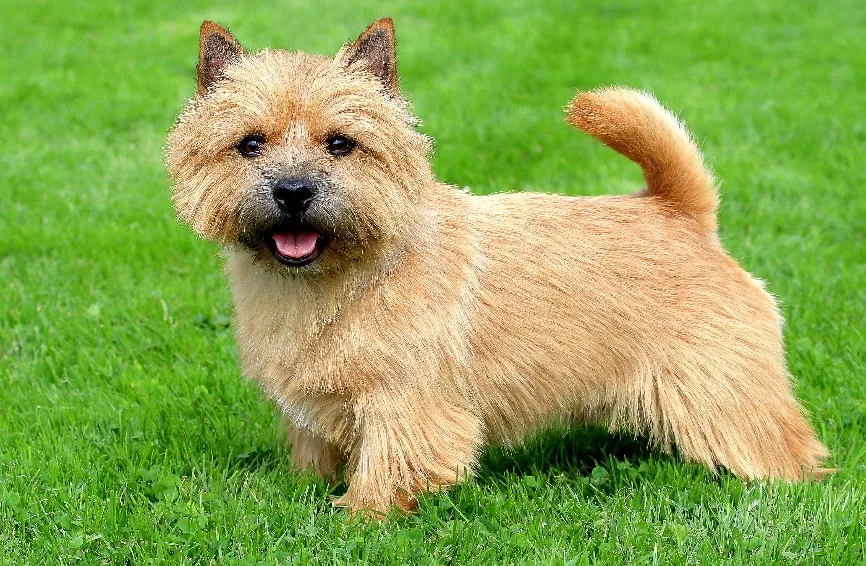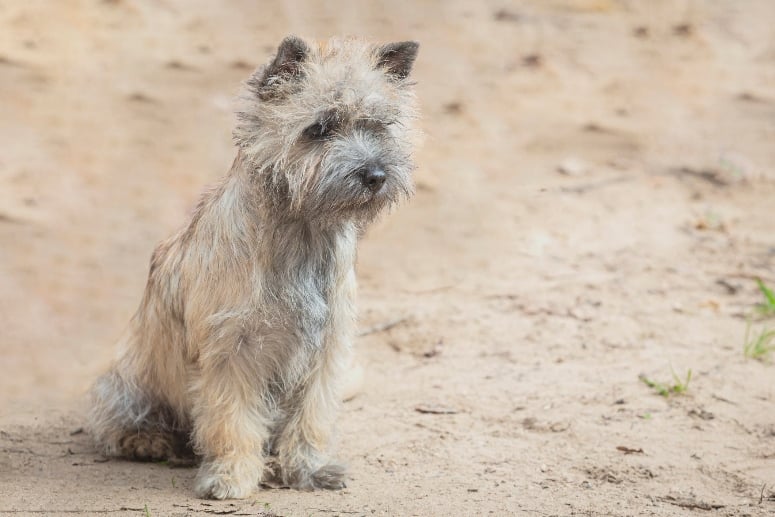Table of Contents
Introduction to Norwich Terriers
Norwich terriers are curious and loyal dogs that love showing affection to the people in their lives. They are named after their hometown of Norwich in England and are among the smallest working terrier dogs.
Despite their tiny size, Norwich terriers are tough and skilled at hunting. They enjoy cuddles and playing fetch, yet they are known for being a bit stubborn during training sessions.
Is a Norwich terrier the right dog for your household and lifestyle? This Healthy Paws breed guide describes everything you need to know about Norwich terriers if you are considering adopting or purchasing a dog of this breed.
Size of Norwich Terriers
When fully grown, a Norwich terrier is about 10 inches tall and weighs 12 pounds. However, people often refer to the Norwich terrier as a “big dog in a little package.” This is because of their eagerness to join you on adventures, cheerful personalities, and strong prey drive that makes them excel at hunting. Females are only slightly smaller than male dogs of this breed.
Here’s how big you can expect your Norwich terrier to get as the dog grows from puppyhood to adulthood:
| Weight Chart | 3 months | 6 months | 12 months | 24 months |
| Male Norwich terriers | 5-7 lbs. | 9-11 lbs. | 11-12 lbs. | 12 lbs. |
| Female Norwich terriers | 4.5-6.5 lbs. | 8.5-10.5 lbs. | 10.5-11.5 lbs. | 11.5 lbs. |
Characteristics of Norwich Terriers
The Norwich terrier is full of life and personality. These energetic and rugged little dogs love being around their family members and going on adventures.
It’s essential to keep your Norwich terrier well-exercised to mentally stimulate your dog and prevent destructive behaviors due to boredom. Norwich terriers are protective dogs that often bark when a stranger approaches the home, yet they warm up to new people rather quickly.
Norwich terriers usually get along well with other dogs and even cats in the household. They are generally good with kids and non-aggressive, but they should never be handled roughly due to the injury risk.
As you get to know a Norwich terrier’s personality, here’s what you can expect based on the breed characteristics:
| Breed Characteristic | Level (High, Medium, Low) |
| Affectionate with People | High |
| Good with Kids | High |
| Good with Pets | High |
| Need for Exercise | High |
| Energy Level | High |
| Intelligence Level | Medium |
| Able to Be Trained | Medium |
| Amount of Barking | High |
| Amount of Shedding | Medium |
History of Norwich Terriers
As the name suggests, Norwich terriers came from Norwich, England and were initially used to help control Britain’s rodent population. They hunted on foxhunts in packs and were also bred to be sociable with people. In the late 1800s, the dogs became famous on the Cambridge University campus because students brought them in as pets.
An Englishman, Frank “Roughrider” Jones, began breeding the dogs in the U.S. around 1914. Over the years, the breed was called the Trumpington terrier and the Jones terrier. However, the English and American kennel clubs recognized the breed as the Norwich terrier in the 1930s. In the 1960s and 1970s, the kennel clubs established the Norwich terrier and the Norfolk terrier as separate breeds. A Norwich terrier, Winky, was featured in a 2000 movie, “Best in Show.”
Norwich Terrier Standard Information
Norwich terriers often compete in dog shows and are judged by their characteristics and appearance. In general, the appearance of a Norwich terrier is spirited and stocky with a foxy expression and sensitive prick ears.
Here is an overview of the breed standard information for Norwich terriers:
Head:
- Small, dark, oval-shaped eyes
- Medium, erect ears
- Wedge-shaped and strong muzzle
- Clean and strong jaw
- Black nose and lips
- Teeth meet in scissors bite
Neck, Topline, Body:
- Medium length, strong neck
- Level topline
- Moderately short body
- Well-sprung ribs
- Short loins
- Tail medium docked
Forequarters:
- Well-laid-back shoulders
- Elbows close to ribs
- Short, powerful legs
- Firm pasterns
- Feet round with thick pads
- Black nails
Hindquarters:
- Broad and muscular with well-turned stifles
- Hocks low set and straight from the rear
- Feet are the same as in front
Coat:
- Wiry, hard, and straight
- Hair is short and smooth on head, ears, and muzzle
- Coat on the neck and shoulders is a protective mane
- Natural coat preferable
Color:
- Red, wheaten, tan, grizzle, or black
- White marks are not desirable
Gait:
- Great power of propulsion
- Hind legs follow track of forelegs
- Topline remains level
Caring for Norwich Terriers
Norwich terriers are smart, working dogs who love having a job to do. It’s important to keep training sessions interesting for these dogs so they don’t get bored.
You’ll need to devote substantial time to getting your dog exercised. However, due to the breed’s strong prey drive, keep your dog on a leash or within a fence when outdoors. As long as you get your Norwich terrier out to exercise daily, these are adaptable little dogs that can live in small or large homes.
Here are some general tips for taking the best care of a Norwich terrier:
Best Living Environments:
- Apartments are fine if the dog is exercised daily
- Plenty of lap time with family members
- Households with kids and pets are generally okay
Type of Exercise:
- Several vigorous 10-15-minute walks daily
- Playtime in a fenced area
- Hikes up to five to eight miles on a leash with family members
- Can run three to five miles if properly conditioned
Mental Enrichment:
- Provide toys for stimulation
- Encourage dogs to burn off enough energy to prevent boredom
- Try puzzles and treat-dispensing toys
- Teach tricks and obedience commands
Training Strategies:
- Breed can be stubborn
- Switch up lessons to spark interest
- Housetraining may be a challenge
- Known to bark frequently if not well-trained
Grooming Tips:
- Brush the weather-resistant coat weekly
- Occasionally strip the coat
- Baths are only needed occasionally and not too often
- Trim nails to prevent cracking and breaking
- Brush teeth daily
Common Health Problems of Norwich Terriers
Norwich terriers are generally healthy dogs that live about 12 to 15 years. However, due to their genetics and breeding, they are prone to certain health conditions.
These are some of the most common health issues that arise with Norwich terriers:
- Tracheal collapse (obstructs airways)
- Patellar luxation
- Hip dysplasia
- Epilepsy
- Degenerative myelopathy
- Elongated soft palate (breathing difficulties)
- Eye issues
- Hypothyroidism
- Liver shunt
Diet and Nutrition for Norwich Terriers
A Norwich terrier needs about one cup of dry dog food daily to be healthy as an adult, although the exact amount of food required will depend on the specific brand of dog food. Therefore, the average daily cost to feed a Norwich terrier is about $1 daily.
One cup of food daily should be split between two meals. Some pet parents use puzzle bowls to slow down food consumption to prevent overeating or eating too fast. These dogs are prone to obesity if they don’t get enough exercise to burn off their high energy.
Where to Adopt or Purchase Norwich Terriers
The Norwich Terrier Club is the national breed club for these dogs and a resource for breeders and information about the breed. The club also has a rescue and rehoming committee to help find families for Norwich terriers needing loving homes.
This is considered a rare breed, with just a few hundred dogs registered each year with the American Kennel Club. They are prone to birth complications that require cesarean sections (C-sections). Meanwhile, females typically only give birth to one or two puppies per litter. Therefore, purebred Norwich terriers tend to be expensive to purchase and challenging to find from reputable breeders.
Related Breeds
If you enjoy what you’ve learned about Norwich terriers, you might also be interested in learning about similar and related breeds before choosing a new dog for your home. Here are some breeds to consider:
- Australian terrier
- Norfolk terrier
- Irish terrier
Pet Insurance for Norwich Terriers
Pet insurance is an excellent idea for Norwich terriers because of how active this dog loves to be and the health conditions it is prone to. Healthy Paws has been the top-rated pet insurance plan for the past seven years and empowers you to give your pets the medical attention they need.
Our dog insurance covers accidents, illnesses, genetic conditions, emergency care, breed-specific conditions, cancer, and alternative care. Join hundreds of thousands of pet parents who agree that pet insurance is worth it, especially with our flexible premium and deductible options, plus no administrative or enrollment fees.
To see Norwich terrier pet insurance rates, enter a few details about your pet, or call us at 855-898-8991 for more information.










